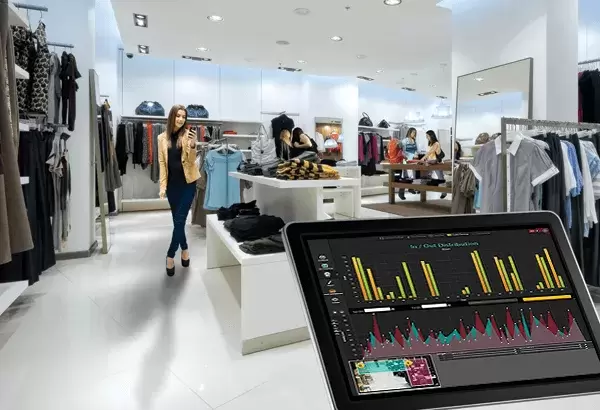The Role and Importance of GMROF for Multichannel and Omnichannel Retailers

In today's fast-paced retail industry, efficient inventory management is crucial for sustained success. As businesses expand their operations to multiple sales channels, such as online and offline retail, to maximize their revenue potential, they need to focus on optimizing the inventory that they have.
With the allocation of inventory or stock categories based on GMROF data, retailers can create a visually appealing and well-organized shopping environment that attracts customers and encourages them to make purchases.
What is GMROF?
The primary means of earning a profit for a retailer is via their inventory investment. GMROF stands for the Gross Margin Return on Footage and measures the inventory productivity by expressing the relationship between the retailer’s gross margin and the area allocated to the inventory. GMROF is generally expressed as a percentage, and it gives the retailers an idea of returns per unit area during a specific time-period.
Importance of GMROF for Offline Retail or Physical Stores
Ratios and metrics such as GMROF are essential for retailers since these can help them identify the profit generating areas within their retail stores. Hence, retailers are now able to make informed decisions regarding the increasing or decreasing allocation of categories within the store. Space productivity is critical for successful retailing and GMROF is the tool that allows retailers to measure it and make changes accordingly.
GMROF helps retailers to increase footfall in their stores, leading to higher sales and more profits. During peak season, tools like GMROF helps retailers display their merchandise in the best possible way, allowing them to take advantage of the extra traffic.
For MBO stores, family stores, departmental stores, supermarkets, convenience stores and other stores that deal in multiple categories or assortments of items, it could be said that GMROF is the most important tool for allocation of space to an assortment.
How to calculate or obtain GMROF?
GMROF is easy to calculate with a billing software or POS software along with an ERP. The POS software can provide the total sales of the particular category or assortment and the ERP can provide the margins of the item on a per unit basis.
First we fix the time period of analysis, it is usually a month or a quarter or a year. Once we have the figures of gross margins earned per unit of the assortment or category we then go into the POS software or billing software to check the total sales of the assortment in the particular store in that period. Next we find out the square foot devoted to selling that item during the given period. We now divide the total gross margin earned (gross margin per unit * no of units sold) by the square foot of space assigned to the category. This is the Gross margin return on floor space.
GMROF = (%GM) * (Total Sales of category from a particular fixture or area of store) / (Sq. Ft. Space of the fixture or area of store)
Is GMROF related to GMROI?
GMROI or Gross Margin Return on Investment is a key metric to find out overall profitability of a store or channel. It can be used to estimate the profit on the particular channel by comparing the margin earned to the inventory held.
The formula for GMROI in retail is = Total Gross Margin earned in a period / Average inventory earned in the period
The period for GMROI is normally a month, quarter or year. Average inventory is the average of the cost of inventory at the start of period and the cost of the inventory at the end of the period.
These figures for total gross margin and average inventory can be easily obtained from your retail ERP.
You may think that GMROF automatically translates to GMROI but it is not necessarily slow. GMROF for a particular category may be high but the rate of sales may be slow, hence impacting the GMROI figure in a negative fashion. It is better to combine the GMROF figure with the Rate of sales (ROS) to get a better understanding of the category in your store or business.
Remember all this data can be easily obtained from a retail ERP and a POS software like that of Ginesys One.
Online Retail and GMROF:
With the rapid growth of e-commerce, online retail has become a major player in the industry. For online retailers, GMROF takes on a slightly different meaning. Instead of measuring footage, online retailers focus on measuring the return on their digital real estate, such as website pages and product listings.
Inventory management software tailored for online retail can provide valuable insights into the performance of individual products or product categories. By analyzing the gross margin and sales data of each SKU (stock-keeping unit), online retailers can identify their top-performing products and allocate more digital space to them. This strategy can help improve visibility and conversion rates, ultimately boosting overall GMROF.
Furthermore, inventory management software equipped with predictive analytics capabilities can help online retailers forecast demand accurately. By leveraging historical data, market trends, and other relevant factors, retailers can optimize inventory levels, reduce stockouts, and minimize overstock situations. This ensures that customers can find the products they want when they need them, improving customer satisfaction and increasing GMROF.
Omnichannel and Multichannel Retail and GMROF:
The rise of omnichannel and multichannel retailing has presented new challenges and opportunities for inventory management. In this model, retailers sell their products through various channels, including physical stores, online platforms, mobile apps, and more. GMROF plays a crucial role in ensuring a seamless customer experience across all channels.
To effectively manage inventory in an omnichannel or multichannel environment, retailers must adopt inventory management software that provides real-time visibility and synchronization of stock levels across all sales channels. This allows retailers to prevent overselling or underselling products, leading to improved customer satisfaction and increased GMROF.
Additionally, retailers need to implement flexible fulfillment options, such as buy online, pick up in-store (BOPIS) or ship from store, to meet customers' expectations for convenience and speed. By utilizing inventory management software that integrates with order management systems, retailers can efficiently allocate inventory from the most optimal location, reducing shipping costs and improving GMROF.
Another important consideration for omnichannel and multichannel retailers is the ability to analyze and understand customer behavior across different channels. By leveraging data from various touchpoints, such as online browsing history, in-store purchases, and mobile app interactions, retailers can gain valuable insights into customer preferences and buying patterns. This information can guide inventory allocation decisions, promotional strategies, and personalized marketing campaigns, ultimately driving higher GMROF.
Conclusion:
In the ever-evolving retail landscape, inventory management software and tools like GMROF are essential for retailers to stay competitive and drive profitability. Whether in online retail, omnichannel, or multichannel environments, leveraging advanced inventory management software like that from Ginesys retail suite allows retailers to optimize their inventory allocation, improve customer satisfaction, and increase GMROF.
By harnessing the power of GMROF, retailers can make informed decisions that lead to better product placement, higher sales, and ultimately, greater profitability. As technology continues to advance, it is crucial for retailers to embrace innovative solutions that enable them to adapt to changing consumer preferences and navigate the complexities of the modern retail industry.



